
|
|
January 9-16, 2002
The Big One: Cincinnati's Legendary WLW
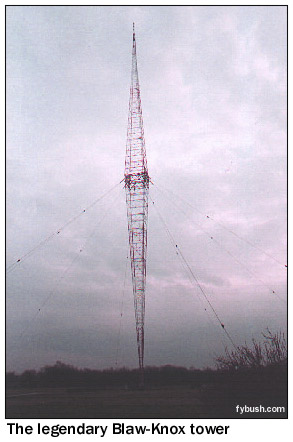 Ask any gathering
of tower hunters (hmmm...now there's an idea!) for a consensus
on the nation's most impressive towers, and you're likely to
find general agreement that the Blaw-Knox diamond towers are
among the most graceful designs ever to be seen at a transmitter
site. (Entire Web sites have used Blaw-Knox towers as central
design elements, in fact!)
Ask any gathering
of tower hunters (hmmm...now there's an idea!) for a consensus
on the nation's most impressive towers, and you're likely to
find general agreement that the Blaw-Knox diamond towers are
among the most graceful designs ever to be seen at a transmitter
site. (Entire Web sites have used Blaw-Knox towers as central
design elements, in fact!)
There are just a handful of these mighty sticks still standing around the country: WFEA in Manchester, New Hampshire; WBNS in Columbus, Ohio; WSM in Nashville, Tennessee; a row of three at WBT in Charlotte, N.C. (those, however, are reproductions; the originals were destroyed some years back in a storm) -- and one other.
(Readers in the New York area may recall yet one more Blaw-Knox tower; WADO 1280, formerly WOV, had such a stick at its site on Paterson Plank Road in the Meadowlands until just a few years ago, when it was replaced during a power increase. Photos of that site do exist in the Site of the Week collection, and we'll feature it later this year.)
That last remaining site is likely to top any list of the most historic AM sites in America as well, and with good reason.
You see, Cincinnati's WLW played a major role in the development of American broadcasting. On the air, the station was one of a handful of prominent programming sources not tied to the coasts and the big networks. Behind the scenes, WLW and founder Powel Crosley worked tirelessly during the 1920s and 1930s to advance the state of radio engineering, including several years as the only U.S. station ever to operate with 500 kilowatts of power and many years as one of the few U.S. stations to operate an international shortwave plant in addition to domestic AM broadcasting.
In later years, WLW remained an important voice in the Midwest and a clear-channel friend to millions from coast to coast. More recently, the station has been the flagship of first Jacor and now Clear Channel Radio, and the personal engineering project of group head Randy Michaels.
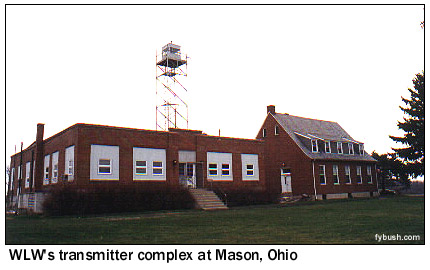 All
that, and the second-tallest Blaw-Knox tower in the nation to
boot, lives on at this site on Tylersville Road in Mason, Ohio,
some 20 miles north of downtown Cincinnati. Your editor, accompanied
by Indiana Radio Watch editor Blaine Thompson, visited WLW in
November 1998 at the kind invitation of Paul Jellison, WLW's
chief engineer.
All
that, and the second-tallest Blaw-Knox tower in the nation to
boot, lives on at this site on Tylersville Road in Mason, Ohio,
some 20 miles north of downtown Cincinnati. Your editor, accompanied
by Indiana Radio Watch editor Blaine Thompson, visited WLW in
November 1998 at the kind invitation of Paul Jellison, WLW's
chief engineer.
Paul and his family actually live at the transmitter site, in the building with the peaked roof at the right side of this picture.
That structure was built in 1927 to house WSAI, a rival Cincinnati radio station (and the ancestor of today's WCKY on 1360, though the WSAI and WCKY calls got swapped along the way, with the original WCKY being the ancestor of today's WSAI on 1530. It all comes back together at the end, as you'll see in a bit...)
In 1928, Crosley bought WSAI and its transmitter site, and on October 4, 1928, WLW burst forth with a 50,000 watt signal - the nation's first - from a 600-foot wire stretched between two 300-foot towers here in Mason. (Until then, WLW's transmitter had been in Harrison, Ohio.)
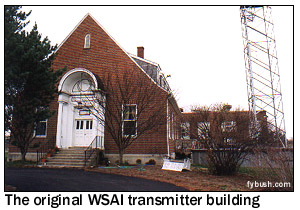
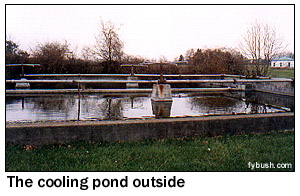
That 50,000 watt signal came from a Western Electric transmitter in the building shown on the left side of the transmitter complex picture above, cooled by water sprayed out of jets in the pond out front.
And even with all that space, still more room was soon needed for Crosley's next big idea. The twenties were an era in which everything that we now take for granted in radio - maximum powers, for instance - was still up for grabs. If WLW could grow from 500 watts to 5000 to 50,000 in just six years, Crosley reasoned, the next logical step was 500,000 watts, and that's just what Crosley was granted on an experimental basis in 1934.
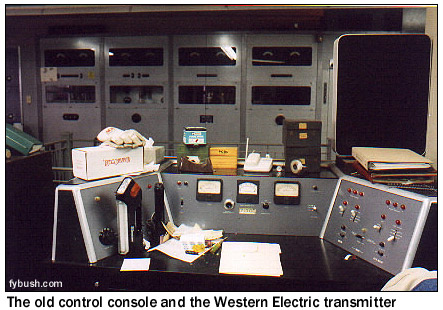
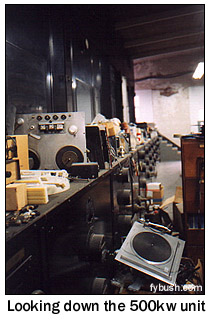
On May 2, 1934, WLW's 500 kilowatt signal, which had been operating experimentally under the callsign W8XO, made its first official appearance, activated by President Roosevelt by remote circuit from the White House at 9:30 PM.
The transmitter, like the signal, was one-of-a-kind. It used the Western Electric 50 kW transmitter to feed a new power amplifier, built into an addition that ran across the rear of the WLW transmitter building, stretching 54 feet long in a row of black cabinets. While the nameplate on the transmitter identifies it as an RCA product, serial number 1, it was actually a joint effort of several manufacturers. General Electric built the RF section, Westinghouse handled the control systems and RCA was responsible for the overall design of the beast, which stands more than 15 feet high and actually has a catwalk halfway up (you can see it being used to store old equipment in the photo above!) to permit easy access to its upper portions.
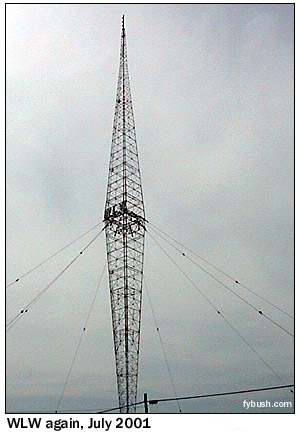 The back wall of
the transmitter is a row of doors that form what appears to be
a hallway along the back of the building. A portion of the old
transmitter has been converted into an RF-shielded room where
the studio-transmitter links and other communications gear are
now housed. The rest of the unit has been scavenged for parts
since WLW returned to 50 kW operation February 28, 1939, though
the engineers' legend has it that the 500 kW rig remained operable
well into the sixties and may even have seen occasional use!
(Crosley never really gave up hope of returning a 500 kW signal
to the air; under the experimental call W8XO, WLW continued some
overnight use of the superpower until the start of World War
II.)
The back wall of
the transmitter is a row of doors that form what appears to be
a hallway along the back of the building. A portion of the old
transmitter has been converted into an RF-shielded room where
the studio-transmitter links and other communications gear are
now housed. The rest of the unit has been scavenged for parts
since WLW returned to 50 kW operation February 28, 1939, though
the engineers' legend has it that the 500 kW rig remained operable
well into the sixties and may even have seen occasional use!
(Crosley never really gave up hope of returning a 500 kW signal
to the air; under the experimental call W8XO, WLW continued some
overnight use of the superpower until the start of World War
II.)
We're getting ahead of the story, though.
When WLW went to superpower operation, it needed a better antenna than the longwire, and so an order was placed with Pittsburgh's Blaw-Knox for an 831-foot diamond-shaped tower, one of the first vertical radiators used in the U.S.
It weighed 136 tons and, I'm told, cost $46,243 to build. As a source of pride in its community, it was adorned at its widest point, facing Tylersville Road, with big white "W L W" letters that remain there to this day, shining brightly at night and visible even from I-75 a few miles to the west.
But there were two problems. First, all that power on 700 kHz caused problems for the next station over on the dial, CFRB Toronto, then on 690. (There were no other stations on 700 in North America; for you young'uns, that's what "clear channel" used to mean back when it still meant something!)
WLW was dialed back to 50 kW at night until the problem could be fixed; the solution turned out to be the construction of a parasitic antenna southwest of the WLW tower across Tylersville Road, one of the first directional arrays ever created, to reduce radiation towards Toronto (and, in the process, towards CKVM on 710 in Ville-Marie, Quebec.)
The other problem, a ring of skywave-groundwave cancellation that ran through Columbus, Indianapolis, Lexington and Louisville, was solved by lowering the tower to 747 feet. Today, it's still at 747 feet, crowned by a three-bay antenna for WYGY (96.5), an FM station that's not even co-owned with WLW any longer!
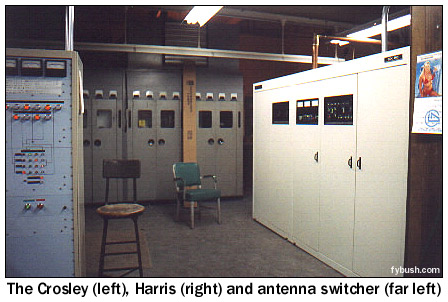 The
old Western Electric transmitter was retired in the 1950s, replaced
by a water-cooled Crosley transmitter (seen at left), built on-site
in a design known as a "Cathenode." While it offered
extremely high audio fidelity, it also consumed an immense amount
of power and was later converted to a more standard plate-modulated
design.
The
old Western Electric transmitter was retired in the 1950s, replaced
by a water-cooled Crosley transmitter (seen at left), built on-site
in a design known as a "Cathenode." While it offered
extremely high audio fidelity, it also consumed an immense amount
of power and was later converted to a more standard plate-modulated
design.
In 1975, the Crosley was replaced for regular use by a Continental 317 (not shown here, but located off to the right of the picture shown at left), which was itself replaced in the nineties with a Harris DX50.
And since our visit, a fifth transmitter has been installed, not far from where we were standing when we took this picture. The Harris 3DX50 Destiny transmitter was one of the first in the country when it entered regular service in March 2000.
Amazingly, all five of the 50 kW transmitters ever used by WLW remain operable. In fact, the old Western Electric, restored in the eighties by a team of Jacor engineers that included Randy Michaels himself, was the transmitter on the air at WLW the night of December 31, 1999, running from 10:45 PM until just past midnight. (No Y2K problems in that unit!)
The antenna switcher seen at the left of the photo above can switch any of the transmitters to the main tower, to a shorter auxiliary tower on near the cooling pond (replaced since my 1998 visit with a newer tower) or to a dummy load.
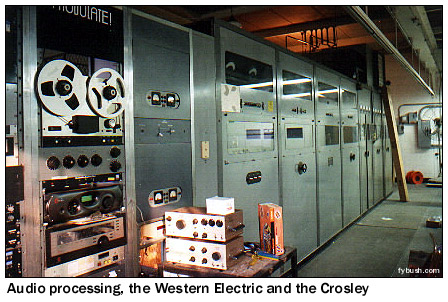 A few
more notes on WLW: the 950 MHz studio-transmitter link is received
behind the transmitter building by an antenna mounted on the
old lookout tower (see the photo at the top of the page for a
look at that); audio processing, at least during my visit, was
being handled by Frank Foti's omnia.fm processor. Yes, that's
"fm" - Jellison said he was impressed with the unit's
sound on AM, and it's hard to find a better-sounding AM signal
out there than WLW.
A few
more notes on WLW: the 950 MHz studio-transmitter link is received
behind the transmitter building by an antenna mounted on the
old lookout tower (see the photo at the top of the page for a
look at that); audio processing, at least during my visit, was
being handled by Frank Foti's omnia.fm processor. Yes, that's
"fm" - Jellison said he was impressed with the unit's
sound on AM, and it's hard to find a better-sounding AM signal
out there than WLW.
I mentioned "shortwave" before, too, and I meant it: using those same W8XO calls, Crosley rebroadcast the WLW signal to the world beginning in the late thirties from another site just to the west down Tylersville Road.
When World War II broke out, the Office of War Administration commandeered the private shortwave stations in America. After the war, government broadcasts continued on many of the former private stations, with the now-renamed Voice of America eventually buying out the private operators like Crosley who had continued to operate the transmitters under contract to the government. Thus was born the Voice of America Bethany relay station, which remained in operation until the mid-nineties. The antennas were already gone from Bethany during my 1998 visit; since then, the land and transmitter building have been converted to a recreation center for area residents.
Now that you've had a taste of the WLW site, I hope you'll go visit the Web page that inspired me to make the trek to Mason back in 1998. Jim Hawkins' Radio Room contains dozens of much better pictures of this building, the other Blaw-Knoxes out there, and much more great radio history and engineering information. Jim even managed to get there on a sunny day for much better pictures of the tower, a feat that's now eluded me on two trips to Mason. (The second, of course, came at the end of the Big Trip this summer, on a day heavy with rain and clouds.)
Go visit...then come back next week as we finally come home to the northeast with a visit to a forgotten regional network and its modern descendants!
Copious thanks to Jim Hawkins for all his extensive research on WLW and its history; to Paul Jellison for giving so generously of his time; to Al Kenyon of Clear Channel for arranging the visit; and to Not Just a Sound: The Story of WLW by Dick Perry (Prentice-Hall, 1971) for additional historical information on WLW. (It's long out of print, but copies surface frequently on eBay and other auction sites. That's where I found mine, and no, it's not for sale.
- Previous Site of the Week: The Big Trip XVI - Lexington
- Next Week: WNSA, Wethersfield and the old Ivy Network
- How can you help support Site of the Week? Click here!
- Submit your suggestions for a future Site of the Week!
